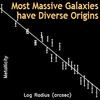Gemini News Archive
Odd Little Star has Magnetic Personality
Press Release | 2007 November 28
Simultaneous observations made by four of the most powerful Earth- and space-based telescopes revealed an unusually active magnetic field on the ultracool low-mass star TVLM513-46546.
Important Announcement from the Gemini Board – November 16, 2007
Web Feature | 2007 November 16
Astronomers Spot Evidence for Colliding Planet Embryos in Famous Star Cluster
Press Release | 2007 November 14
Astronomers have found evidence for the formation of young rocky planets around the star HD 23514 located in the well-known Pleiades (Seven Sisters) star cluster that is easily visible in the current evening sky.
Are "Fossil Groups" Morphed from Cannibalized Galaxies?
Web Feature | 2007 November 5
A team studied the dynamical properties of CG 6, a massive compact group at a redshift z=0.22, that has several properties in common with known fossil groups. The study is based on multicolor imaging and deep spectroscopic observations obtained with GMOS at Gemini South.
Most Massive Stellar Black Hole Found
Web Feature | 2007 October 17
Observations that combine data from the ground-based Gemini North telescope and NASA’s orbiting Chandra X-ray observatory have led to the discovery of the most massive known stellar black hole.
The Gemini Deep Planet Survey - First Results
Web Feature | 2007 October 8
A Canada-US-UK team has released the first results from the Gemini Deep Planet Survey (GDPS), a near-infrared adaptive optics search for giant planets and brown dwarfs around 85 nearby young stars.
The 400th Gemini Paper
Web Feature | 2007 September 27
Most Distant Quasar Samples Conditions in the Young Universe
Web Feature | 2007 September 24
The GMOS South spectra were taken in the nod-and-shuffle mode, necessary to measure the weak residual flux at wavelengths shorter than the Lyman emission line in order to determine the absorption by neutral hydrogen.
Quasar Pairs Reveal Distant Galaxy Clusters
Web Feature | 2007 September 11
An international team of researchers has shown that quasar pairs may be excellent beacons for finding clusters of galaxies in the early universe.
Gemini's Impact on Deep Impact
Web Feature | 2007 September 5
By observing the comet Tempel 1 pre-, and post-impact, the Harker team gathered baseline data sets with MICHELLE on Gemini North to compare with data obtained during the moments surrounding impact.
NIFS Dissects the Heart of HL Tauri's Jet
Web Feature | 2007 August 29
A team used the adaptive optics fed integral-field spectrograph NIFS on Gemini North to explore the inner structure of the jet in the young star HL Tau, located about 460 light years away in the constellation of Taurus.
Uncovering a Missing Link Between Dwarf Galaxies and Globular Clusters
Web Feature | 2007 August 17
Deep Gemini imaging of the cluster of galaxies Hydra I at a distance of 176 million light-years has revealed an abundance of massive luminous metal-rich globular clusters that appears to impersonate ultra-compact dwarf galaxies.
Frenetic growth of supermassive black holes in the early universe
Web Feature | 2007 July 31
The six distant quasars a team observed are at redshifts ranging between z = 5.8 to 6.3 and correspond to a period when the universe was only about one billion years old. Using GNIRS at Gemini South and NIRI at Gemini North, the team found these very young quasars to be already super-enriched in heavy elements.
Charon: An Ice Machine in the Ultimate Deep Freeze
Press Release | 2007 July 17
NIRI observations with AO showed evidence of frigid geysers spewing material up through cracks in the crust of Pluto's companion Charon and recoating parts of its surface in ice crystals.
Young Stars Swim in Pools of Molecular Hydrogen
Web Feature | 2007 June 27
During a search for hydrogen emission in the disks of young stars, UK astronomers have discovered a massive layer of hot gas around a low-mass M3-type star in the 6 million-year-old Eta Chamaeleontis cluster.
Astronomers Converge in Brazil for 2007 Gemini Science Meeting
Web Feature | 2007 June 18
Amidst the stunning beauty of the Foz do Iguaçu park and waterfalls in Brazil, more than 130 astronomers and staff from the seven-country Gemini partnership converged during the week of June 11th, 2007.
Discovery Narrows the Gap Between Planets and Brown Dwarfs
Press Release | 2007 May 30
The coolest-known star-like object, called ULAS J0034-00 and located in the constellation Cetus, has a record-setting surface temperature of 600-700 K, cooler than any known solitary brown dwarf.
Distant and Massive Galaxy Cluster Revealed in Gemini Deep Deep Survey Field
Web Feature | 2007 May 25
Deep HST and Spitzer imaging of a passively evolving galaxy identified in the Gemini Deep Deep Survey (GDDS) has led to the detection of a very compact cluster of massive red galaxies at a redshift of z =1.51.
GNIRS Recovery
Web Feature | 2007 May 15
For some unknown reason the GNIRS temperature controller failed, resulting in temperatures near 200° C for an undetermined period of time. After the initial inspection, it was obvious that some components were damaged, but many were clearly fine.
Most Massive Galaxies have Surprisingly Diverse Origins
Web Feature | 2007 May 14
An Australian team used the Gemini South Telescope to find that the most massive galaxies evolve through a variety of mechanisms which are dependent on the mass of their cluster environment.



















